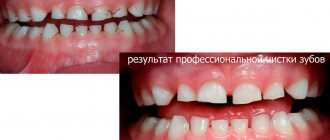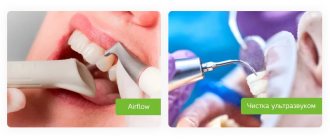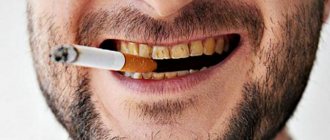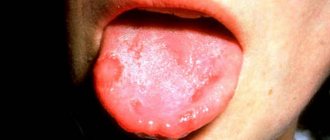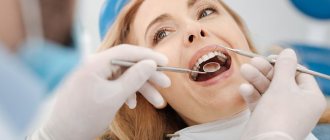What is Priestley's plaque
Plaque on baby teeth of a yellowish, black or brown color appears in a child when bacteria actively multiply in the oral cavity. Priestley's plaque is often seen at an early age, but can also occur in older children. When deposits appear, teeth lose their attractiveness, which can negatively affect the child’s psychological state. If symptoms of this unpleasant phenomenon develop, you should immediately contact your dentist to eliminate Priestley’s plaque in children.
The child has yellow teeth. Reasons and what to do?
There is nothing better than a dazzling smile. For people whose work involves communication, a snow-white smile is the norm. And to ensure that their teeth always look pleasing, they go to great lengths: constant visits to the dentist, whitening procedures, expensive care. But what to do with children who, from a very early age, have unattractive yellow teeth? Parents should understand that dental plaque contains a lot of pathogenic bacteria, which very often lead to inflammatory processes in the throat and oral cavity.
Very often, parents do not attach importance to this problem, believing that yellowness on baby teeth does not pose any threat to the child’s health. There is an opinion that these teeth, as a temporary phenomenon, do not require special attention from the dentist. In practice, this is not the case at all. If you do not pay attention to the yellowness of your teeth in time, then in the future quite serious dental problems in the oral cavity may arise.
Causes of yellowness
1. Heredity. It will not be surprising if parents with yellow teeth discover this problem in their child. However, the hereditary factor does not often become the determining factor; most likely, the reason will be completely different.
2. Improper oral care. If a child does not know how to brush their teeth, they will most likely have visible yellow plaque stains. It is very important for parents to teach their child how to properly use toothpaste and a brush and, if possible, control this process. Parents wipe the first teeth with a soft brush after each feeding. After the baby has already learned to hold this instrument independently, he should be taught to brush his teeth correctly. The paste and brush are selected according to age, and all manipulations must be carried out under the strict supervision of adults. Dentists recommend monitoring this process until the child turns 10 years old. Children who wear orthodontic elements in their mouths require special control and assistance. The best option for them is to have their teeth professionally cleaned at the dentist's office every month.
3. Thinned enamel. The white color of teeth is provided by enamel. If it becomes thinner, dentin, which has a yellow tint, begins to show through. This is what causes teeth to turn yellow. Thin enamel can be present from birth, in other cases the problem arises due to improper brushing of teeth, incorrectly selected toothpaste and brush, as well as from drinking a large amount of carbonated drinks. But the most common cause of thinned enamel in a baby is the pathology of the mother’s pregnancy.
4. Taking medications. You should be aware that some medications can cause yellowing of the enamel on your teeth. These include the antibiotic tetracycline or amoxicillin. Even taking these drugs by a pregnant woman will cause the baby to have yellow teeth.
5. The cause of yellow teeth in children can be developmental pathologies in the womb.
6. Acquired diseases also affect the color of tooth enamel in children. For example, children who have had jaundice develop a dark brown plaque on their teeth. If a child has digestive problems, his teeth will also have a yellowish-brown tint.
7. Mechanical damage. The impact can chip the enamel on your child's teeth, resulting in unattractive yellow stains.
Methods for dealing with yellowed teeth in children
You need to understand that the hereditary cause of yellow teeth has no cure. All you can do for your child is to visit the dentist at the Sanation clinic on time and perform teeth whitening procedures.
1. Professional cleaning involves removing tartar and plaque, followed by coating the tooth with silver or fluoride varnish.
2. Whitening can also be done in a dental office. But if you don't have enough time or money, there are a few simple tricks that can help restore the whiteness of your child's teeth. The most famous: rinsing the mouth with water and lemon juice, chewing parsley leaves.
3. Teeth whitening with ultraviolet light. This method is good for cleaning teeth that have become yellow from taking medications. Under the influence of ultraviolet light, the antibiotic dissolves and the teeth become white. But to use ultraviolet lamp cleaning, strict indications are required; they can only be determined by a doctor.
4. Exclusion from the diet of foods containing artificial colors. To avoid staining your child’s teeth, you should avoid all carbonated drinks and colorful sweets. The consumption of these products not only stains the enamel of teeth, but also very often leads to caries.
5. Mechanical cleaning. You can get rid of yellow plaque on children's teeth using a special abrasive paste and brush. But it should be noted that this manipulation can only be carried out in a doctor’s office and no more than once every 3-4 months. Brushing on your own can damage tooth enamel, which can lead to even more dental problems.
6. Cleaning with special preparations. There are a number of medicinal ointments and solutions, the use of which effectively whitens a child’s tooth enamel. These include Remodent, Gluftored, Profokar. As a rule, the correct use of these products at home does not cause any harm to the child’s health.
To prevent your child from having yellowed teeth, you need to carry out preventive measures in a timely and efficient manner:
- brush your teeth twice a day (starting with milk teeth);
- visit the dentist’s office at least once every two months for an examination;
- monitor the child’s proper and balanced diet;
- Have your teeth professionally cleaned at least once every six months.
Helpful information
Children's dentistry
Causes of black plaque in children
The main causes of black plaque on teeth are:
- Priestley plaque is the main cause of deposits. Growing up, the child gets rid of this problem, since plaque almost never settles on permanent teeth. This phenomenon does not harm health and is characterized as a purely aesthetic defect.
- Tooth decay is a serious disease that can lead to tooth loss. The carious process is accompanied by yellowing and subsequently blackening of the tooth enamel. When the first symptoms appear, you should immediately consult a dentist.
- Dysbacteriosis is a disease that leads to the appearance of dental plaque due to disturbances in the functioning of the digestive system. The causes of the disease are poor diet, long-term use of medications, chronic diseases affecting the liver or intestines.
- Oversaturation of the body with iron. Prescribing iron-containing medications to children leads to the formation of both black plaque and deposits that are dark purple or brown in color.
In addition, teeth can darken due to a lack of calcium in the body caused by some disease. In general, the exact cause will be revealed during an examination by a dentist.
Provoking factors
The main reason why tartar forms in young children is poor oral hygiene. Even parents are not always able to thoroughly clean children’s teeth, so, as a rule, large plaque accumulates in hard-to-reach places.
The provoking factor may be:
- lack of solid food in the child’s daily diet;
- bite pathologies;
- long-term use of antibiotics;
- gastrointestinal diseases.
It is not always possible to eliminate the provoking causes of tartar in a child, so dentists recommend that parents constantly monitor the quality of their teeth cleaning.
What does ignoring the problem lead to?
Failure to promptly contact a dentist when plaque appears on baby teeth leads to the following negative consequences:
- development of the inflammatory process;
- bleeding gums, which occurs if the child eats or brushes his teeth;
- the likelihood of developing diseases such as caries, stomatitis and periodontal disease increases;
- milk teeth with a black coating are very unaesthetic, which is fraught with the development of complexes in the child;
- deposits may be accompanied by bad breath.
What kind of stone is there?
There are two types of tartar:
- supragingival;
- subgingival.
They differ from each other in location.
Supragingival calculus is easy to see, it is grayish or yellowish in color, and is easy to scrape off from the tooth. The appearance of such a stone can be blamed on the minerals found in saliva. Most often, this type of deposit is based on the front teeth and buccal surfaces of the molars of the upper jaw.
Subgingival stone can only be detected by a dentist. At Family Dentistry, the doctor will definitely conduct a diagnosis in order to detect deposits or make sure that they are absent. This type appears due to gingival fluid containing minerals. This stone is either greenish or dark brown, attached to the neck of the tooth, on the root cement, in the periodontal pocket.
Visually, it can only be seen if the disease is advanced - the deposit covers the neck of the tooth, and protrusions form.
Preventing the reappearance of black plaque on teeth
Prevention of plaque formation includes:
- Regular dental and oral care. For babies, their gums are cleaned using cotton pads and special silicone tips. When the baby turns two years old, he needs to be taught to properly brush his teeth with a brush and toothpaste, as well as to regularly rinse after meals.
- Balanced diet. Your child's diet should include fewer sugar-laden foods and more natural fruits and a variety of vegetables.
- Timely limitation of the use of pacifiers and bottles. Long-term use of these items leads to the appearance of malocclusion, the development of a certain dependence, and the formation of so-called “bottle caries.” If a child can do without a pacifier and bottle, they should be disposed of.
In addition, you should constantly monitor the state of the child’s immune system and support it with the help of vitamins, which have a beneficial effect on the health of the teeth and the whole body. If you follow these simple recommendations, your child will always delight his parents with his beautiful and healthy smile.
Methods for removing tartar
The dental procedure for removing tartar from teeth is painless and safe. This can be a separate manipulation or a stage of professional cleaning of tooth enamel.
Removal of supragingival tartar can be performed by two methods:
- hygienic cleaning - with professional toothpaste and a special brush;
- Airflow method - a hardware technique for cleaning teeth with soda crystals flowing through a nozzle under pressure with an air flow).
It is more difficult to get rid of subgingival deposits, so more effective methods are used:
- manual cleaning - the doctor uses a tool to separate the tartar from the enamel;
- ultrasonic cleaning - deposits are destroyed by ultrasonic waves and then removed with a tool.
The procedure is completed by polishing the tooth. To strengthen damaged tooth enamel, a remineralizing composition and fluoride varnish are applied to the surface of the tooth.
DIAGNOSTICS
Priestley's plaque itself is not dangerous to the body, but dark spots can also occur for other reasons. Therefore, you should always rule out risks and check with a dentist.
In cases where a stain appears on a tooth, diagnostics is carried out using a laser. This helps the specialist determine how deep the caries has spread, as well as its stage. After diagnosis, individual treatment is prescribed based on the data obtained.
If the dark plaque was not caused by caries, the specialist will prescribe additional tests that will identify the problem.
Tooth enamel: general characteristics and properties
This is the hardest and most durable tissue in our body, its thickness on the outer surface reaches almost 2 mm. It consists of many layers formed at various stages of mineralization and has a crystalline structure. The chemical composition is represented predominantly by apatites, calcium and phosphorus predominate from inorganic compounds, and proteins, lipids and carbohydrates from organic compounds.
The main function is to protect dentin from external factors: mechanical, chemical and temperature stimuli. Thanks exclusively to this tissue, teeth can fulfill their main purpose - grinding and chewing food.
Despite its extraordinary strength, enamel is permeable to water and many organic and inorganic substances contained in saliva. It has been found that the degree of permeability for much-needed connections depends on several factors. If we talk about temporary occlusion, this is:
- condition of the oral cavity;
- nutritional features;
- long-term treatment with certain medications (in particular, tetracycline antibiotics);
- features of intrauterine development.
Enamel maturation
The composition of the protective tissue covering dentin is constantly changing, which is associated with age-related characteristics. Throughout the year after teething, there is an active accumulation of calcium and phosphorus, and during this period it is extremely important to receive all the necessary elements with food or multivitamin preparations. It has been proven that a sufficient content of microelements prevents the development of caries.
Why do teeth darken?
When a child develops dark plaque, this indicates the proliferation of pathogenic microbes that are deposited on the tooth enamel.
Black deposits may be a sign of:
- thyroid diseases;
- diabetes mellitus;
- helminthiasis;
- dysbacteriosis;
- immunity disorders.
Dark plaque on a child’s tooth enamel appears due to dental pathologies:
- tartar;
- caries;
- mineral deficiency;
- enamel hypoplasia;
- malocclusion.
The cause of tooth discoloration may be the effect of dyes, a disorder in the intrauterine development of the child, or a genetic predisposition.
How to prevent it?
The main task of parents is not to cure the disease, but to prevent it! Therefore, certain measures should be taken to prevent mineral deposits on teeth:
- As soon as the first teeth appear, you need to teach the child to eat solid food, do not follow the lead of the little lazy person - do not chop carrots and apples;
- You should brush your teeth with a children’s brush, which is better to buy on the recommendation of a dentist;
- You need to change the brush every 2-3 months;
- Teach your child to brush their teeth correctly. The doctor will give you all the necessary recommendations at your appointment.
- purchase pastes with pyrophosphate (but strictly in accordance with the age of the baby).
But the most important rule is to bring your child once every six months for a dental examination. This will not only help get rid of tartar, but also prevent serious diseases in the future that are caused by mineral deposits: periodontitis, gingivitis, stomatitis.

